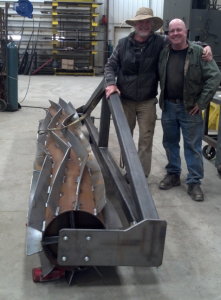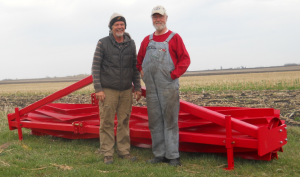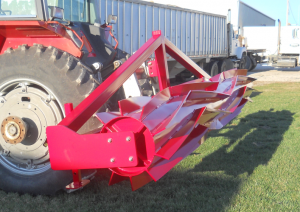Final report for FNC16-1055
Project Information
Two separately managed 40 acre fields, conventional and no-till, tested effects of roller crimping and an organic bio-soil enhancer on weed suppression, cover crop winter hardiness, soil properties, overall plant health and cash crop yields.
There were two individually operated farms participating in this project. The coordinator and partner farmers were Billy Sammons and George Naylor. Billy Sammons operates a 120 acre farm which was in the first year of organic transition at the start of the project. For the prior three years, the farm was under a soybean/corn no-till rotation system. The farm was ridge tilled for 10 years prior to those three years. Non-GMO corn, conventional soybeans and alfalfa have been the main cash crops.
In the past, injected liquid N was the primary fertilizer. Herbicides containing glyphosate were used sparingly to control heavier annual and perennial weed pressure through spot treatments. There was one burn down right after planting. Pesticide for aphid control on soybeans was sporadically applied as was insecticide for corn ear worm infestations.
There are nearly 35 acres of CRP land on the farm, including a recent eight-acre addition of quail habitat and a one-acre pollinator strip. The goal is to attract beneficial insects and minimize the use of any National Organic Program acceptable insecticides. CRP land now buffers the 79 acres of cropland on all sides.
Farming experience for Billy Sammons besides the present farm includes farming 160 acres of wheat, barley, and lentils in Washington State for seven years in the late 70's and early 80's. Since then, Billy has worked on and off with many different farmers over the years. He is considered a historically underserved farmer under USDA’s Environmental Quality Incentive Program (EQIP) standards and was recently assigned the sole operator of the present farm by the USDA Farm Service Agency.
Billy's transition-to-organic EQIP application is presently in the third year implementation stage and focuses on the NRCS practices of Cover Crops (340), Nutrient Management (590) and Conservation Crop Rotation (328). His USDA Conservation Activity Plan supporting organic transition was approved (CAP-138) and he is working closely with NRCS staff and a USDA certified organic Technical Service Provider (TSP). A Nutrient Management Plan (CAP-104) was completed in 2016 and presently in implementation.
The partner farmer, George Naylor, is the coordinator's neighbor and mentor. George, past President of the National Family Farm Coalition, has been farming corn and soybeans for 40 years on his non-GMO farm of 400+ acres. George is known in the farming community as a risk-taker when it comes to eco-friendly methods of non-gmo crop production.
Like the coordinator, George has recently committed over 25 acres to quail habitat as part of CRP land, included another five acres of pollinator strip, experimented with cover crops and planted an organic orchard consisting of over 250 trees. George has also transitioned an 85-acre portion of his farm to organic operation and 40 additional acres are in the third year of transition. For the three years prior to the start of the project, Billy and George had been working together developing plans for organic transition and experimenting with various sustainable farming practices.
As pointed out by Jeff Moyer of the Rodale Institute, cover crops are the key to an effective organic no-till farming system. Cover crops reduce erosion, suppress weeds, hold moisture, provide sanctuary for beneficial insects and ultimately build soil organic matter. Our goal in this project was to experiment and compare different production techniques in an effort to develop a sustainable corn and soybean production system using cover crops and the no-till approach.
We want to maximize our ability to build carbon reserves and the organic no-till system offers a unique opportunity in that direction. Our project also tested the application of an organic microbial formulation that has been shown to help bio-stimulate various populations of beneficial soil organisms, while helping to improve the natural integrity of the soil.
We broadcast the rye cover crop seed at 3bu/ac using a modified Hagie on September 15, 2015.
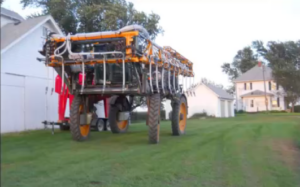
We documented growth daily for the first week and then bi-weekly on each partner’s field until it was crimped.
Mother nature provided 1.3" of rain a few hours after broadcasting the seed.
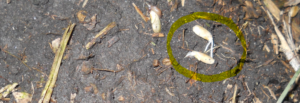
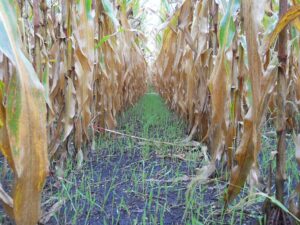
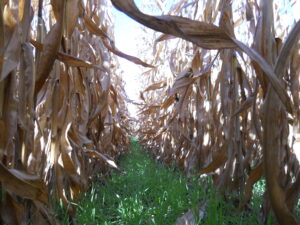
18 hours 4 days 7 days
Roller Crimper Manufacturing: The roller crimper was designed after an I & J model and built by a local metals fabricator. A modified chevron design and thicker gauge steel was used to increase dry weight and down pressure. The result was a highly efficient 3-pt crimping tool:
We planted soybeans with 15" row spacing into the standing rye on 5/20/2016 and then crimped immediately afterwards over the next two days. We crimped twice, once in each direction, to minimize re-growth. The rye height averaged over 5' tall. Here is a quick peek at how it worked:
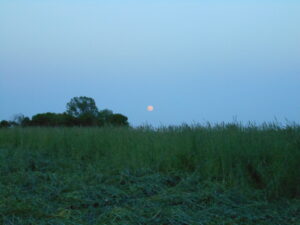
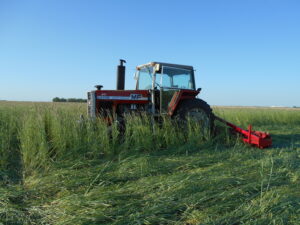
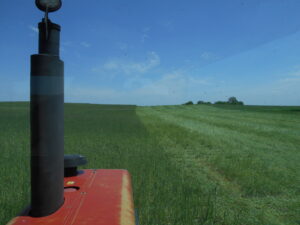
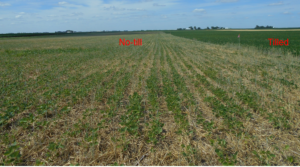
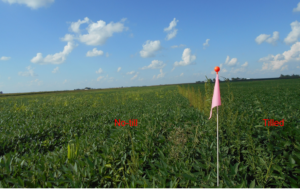
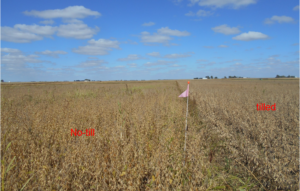
7/01/16 8/15/16 10/01/16
In the Partner’s tilled field comparison, the soybeans were growing normally, but so were the weeds. Within a month, the soybeans in the no-till field caught up to their tilled counterparts with continued excellent weed suppression. Mechanical, physical and NOP-compliant herbicidal weed control costs in the tilled field eliminated any initial yield benefits according to calculations using the Ag Decision Maker averages for labor, fuel, materials and equipment depreciation costs.
What we’ve learned so far:
- Cultivar selection…winter hardy AND early maturing. We crimped at the 25 – 50% anthesis rate due to incoming storms and the later maturing cultivar (Rymin). Using an earlier maturing cultivar (Aroostook or Elbon) and waiting until a higher rate of anthesis would lessen the need to crimp twice.
- Planting…drill vs broadcast. This depends upon harvest date. Broadcast provides better distribution of seed and cover when there is adequate moisture. Drilling provides better assurance of germination in drier conditions, but with gaps, which tend to offer enough light for weed growth.
- Biomass…retains moisture, provides adequate weed suppression and builds organic matter. Three – four bu/ac seems necessary to provide adequate biomass for weed suppression and prolonged allelopathic effects.
- Anthesis rate at crimping…the higher the level, the better initial termination. However, in comparison to some neighbors who crimped at a higher level of anthesis, yields and weed suppression effects did not differ.
Describe your work plan for Year two:
We aerially applied a combination of oats and hairy vetch onto each of the soybean fields on 9/13/16. The bio-soil enhancer was ground applied on trial plots on 10/17/16. We want to see if the bio-soil enhancer helps the hairy vetch to over-winter and determine the extent to which N mobilization reduces the need for any additional fertilizer. Growth records and soil-health data collection will follow a similar protocol as in Year 1.
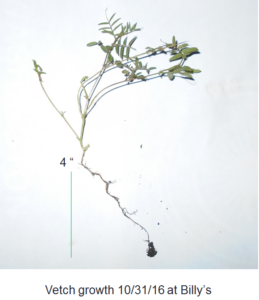
We aerially applied Elbon rye cover crop seed onto the cornfields on 9/10/16. We will determine if an earlier maturing variety allows for earlier soybean planting and crimping of the rye afterward.
Although not part of the study, it is worth noting that the Elbon rye produced well, although the stalks were a bit thinner than the Rymin rye used last year. We also had some issues with aerial broadcasting as the bordering areas of the fields had much less growth than the interior portions. This factor led to more weed pressure in those areas and corresponding lesser yields.
The hairy vetch did overwinter on both farms and began growing vigorously by mid-April. The effects of using the bio-soil enhancer were negligible and difficult to measure due to outliers in the data collection on some plots. Data were collected to measure biomass and potential N.
Fertilization
No fertilizer was applied on either field in Year one of the study. The bio-soil enhancer was applied on each of the farm's 8, 2.5ac plots as depicted in the chart and Billy applied the bio-soil enhancer on the rest of his 40-ac field at the same rate of 1-gal/ac.
In year two, each farm had raw chicken manure applied at the rate of 2.5T/ac around the middle of November, 2016. The bio-soil enhancer was foliar applied in late June at the same 1-gal/ac rate on each of the same plots as depicted in the chart.
Data Collection and Analysis
A team of ISU graduate students, led by Dr. Ajay Nair, associate professor in the Horticulture Dept. at Iowa State University, visited the fields on several different occasions to collect data about soil health and physical plant profiles. Analyses commenced at the ISU Vegetable Production Lab.
Results
We had good success in year one planting soybeans into standing rye and then crimping the rye post-planting. There were some issues with the rye standing back up, but an additional crimping solved that issue. Adequate weed suppression occurred for the entire growing season and yields were similar on both farms, approximately 50/bu/ac. There was no pest pressure on either farm. We want to extend our findings in another project to determine if planting can occur earlier and if crimping can occur after the beans have emerged and reached a specific growing stage. We want to experiment with variable planting and crimping date strategies.
In year two we experienced mixed results. The Hairy Vetch survived a rather mild winter and there was no significant difference between the bio-soil enhancer and control plots. The coordinator had issues terminating the hairy vetch at 50% flowering and even after another crimping and two times mowing, the vetch still survived. This created an issue for the corn as the vetch dominated the nutrients and moisture. The tangling vines also created a strangling effect that impeded upward growth. A no-till Buffalo, single sweep cultivator was used in an effort to salvage the corn yield, but was too late and the yield suffered significantly (180bu/ac average to 55bu/ac in this experiment).
In the Partner's conventional field, the vetch was incorporated at about one foot of growth. In approximately two weeks, the N from the vetch became available and the corn grew with vigor. The Partner cultivated the field twice during the season and in-row weeds were minimized. Both farms planted the same cultivar of corn on the same day and experienced similar, limited rain events during the growing season. Yield at the Partner's conventional field was approximately 140bu/ac. The no-till portion of the Partner's field was incorporated prior to harvest due to the strangulation affect of the hairy vetch.
We learned that hairy vetch can supply a good amount of N (approximately 100lbs/ac in our case) but the timing of that is dependent upon growth stage, moisture availability and termination date. Termination of vetch needs to occur at "full-flowering" and in order to plant corn at a reasonable date (5/1 - 5/15) an earlier cultivar of hairy vetch is imperative, e.g., Purple Bounty. In addition, incorporation of the vetch seems to prevent competitive interference and also accelerates nutrient availability. This finding creates a significant challenge for a no-till operation.
One possible solution, as suggested by Jeff Moyer in a conversation at the Iowa Organic Association Annual conference this year, is to mow the vetch early in the Spring. In trials at the Rodale Institute, mowing early seems to "trick" the vetch by accelerating its reproductive metabolism and forcing it to flower earlier than normal. We would like to try this approach because at Rodale, the N from the vetch provides nearly all that is needed for their corn fields. If we can duplicate this practice in Iowa, we could roller crimp the vetch and plant our corn earlier, effectively control the potential of nitrate leaching, still provide adequate weed suppression, minimize the need for supplementary N and continue to build organic matter.
Here are the technical findings from the total analyses:
Final-Data-for-George-with-yield
We had three main hypotheses for our project:
- 1) If cereal rye can develop enough biomass, then after-crimping weed pressure will be minimal in a no-till vs conventional till system before soybeans.
- 2) If a bio-soil enhancer can promote increased microbial activity, then N uptake will accelerate canopy formation, facilitate prolonged weed pressure control and improve pest resistance.
- 3) If a bio-soil enhancer can improve fall hairy vetch root formation, then winter hardiness will improve, along with subsequent after-crimping spring N mobilization before corn.
Here is the trial design of 8, 2.5ac plots on each farm with 4 replications of with or without the bio-soil enhancer:
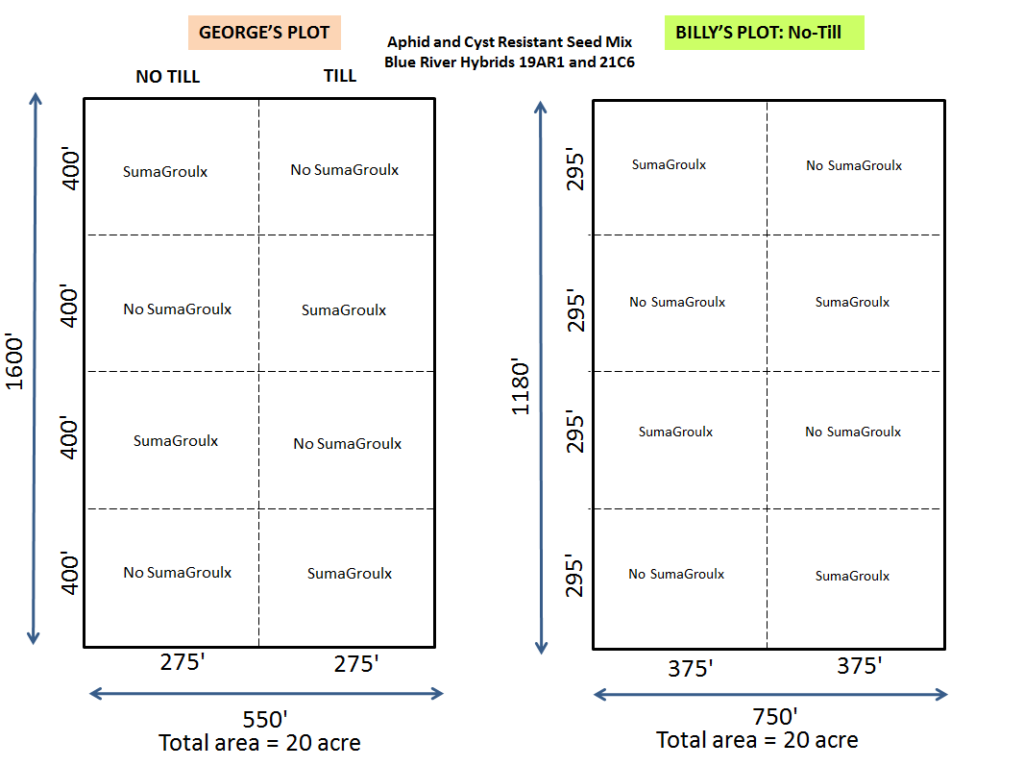
Here are the data from Hairy Vetch Biomass collection and N contribution analysis for both fields:
Billy
|
Grower |
Treatment |
Hairy vetch biomass (lb/A) |
Potential N contribution (lb/A) |
|
BS |
Sumagroulx |
3,143 |
111.0 |
|
BS |
No Sumagroulx |
3,318 |
113.8 |
George
|
Grower |
Treatment |
Hairy vetch biomass (lb/A) |
Potential N contribution (lb/A) |
|
GN |
No-till No-Sumagroulx |
3,212 |
112.1 |
|
GN |
No-till Sumagroulx |
2,484 |
58.1 |
|
GN |
Till No-Sumagroulx |
1,408 |
32.9 |
|
GN |
Till Sumagroulx |
3,102 |
89.7 |
Hairy Vetch
We roller-crimped the vetch on 5/31/17 in an effort to terminate it at about 50% flower blossom. However, the vetch stood back up in a couple of days and seemed unaffected. So, we crimped it again, but with the same results. Then, we mowed it with a 7' John Deere rotary mower. Unfortunately, this seemed to just invigorate the vetch and it grew back quickly and even thicker. So, we mowed it again, but it was minimally effective. Put simply, at 50% flower stage, the vetch was impossible to terminate mechanically:
After about two weeks we tried cultivating the corn, but had to mark the rows with about 2500 flags so we could see the rows...then about three weeks later we cultivated again with the same no-till Buffalo single sweep cultivator:
Unfortunately, we were late in the growing season and since we did not have disc hillers to help with in-row weed suppression, the vetch still out-competed the corn and limited its growth. As a result, yield was significantly compromised.
You can see the effects from the first pass on July 23rd. Keep in mind, the rows are in the middle of the hash marks of the shovel shank:
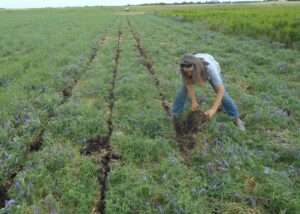
Here is a pic three weeks later and you can see how the vetch in-row grew with even more vigor after killing the between-row vetch. As a reminder, the vetch was roller crimped on 5/31 and again on 6/8, then mowed on 6/20 and again on 6/30.
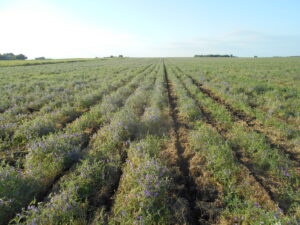
We harvested on 11/16 at Billy's and the corn averaged about 4' tall with small ears. The cultivars, 9700 and 9717 from GEI seed, were a medium height, 102 (north) and 110 (central) RM variety. In a section of the field that is more fertile, there were some places the corn was 6 - 7' with large ears and the vetch was also patchy in those areas. There was also about 9ac around the perimeter of the field on which very little vetch had grown. This happened, in part, because the ground in those areas is less fertile and the applicator either ran out of vetch or perhaps the wind broadcast more toward the interior. The yield was worst in those areas and over the entire 42-ac field, was about 55bu/ac, with a range from 0 - 100.
Example of no-vetch along a 60' wide headlands section of the field. It was like this around the entire field that was adjacent to our 50 - 80' buffers.
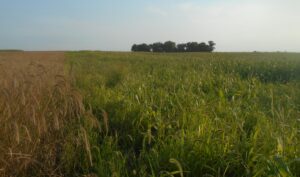
George harvested his 10-ac tilled plot on 11/8/17. The vetch had been incorporated when it was less than a foot tall. The corn was about 7' on average. The yield, with the same cultivars, was between 130-140bu/ac. The ears were large and full. We did not collect data from George's 10-ac no-till field since the vetch had taken over. George disked most of it and what corn had grown was sparse.
Cooperators
Research
The two farms are located about three miles apart on the same road. This proximity made it easy to share use of the roller crimper and other equipment. In addition, weather events were similar as was overall growing conditions. The partners used the same cultivars of soybeans, corn and cover crops. The planting dates for the cover and cash crops were the same...the middle of September for cover crops and the end of May for cash crops.
Data on biomass and nutrient content were collected by a team of Iowa State University graduate students on a set schedule and analyzed in the vegetable production lab on campus.
Outreach:
- We held a Practical Farmers of Iowa (PFI) Field Day on 6/15/16 and over 120 people attended from five surrounding States.
http://www.practicalfarmers.org/blog/2016/06/22/rolling-2016-field-day-season-churdan/
- An interview by Stefan Gailans, Ph.D., with Francis Thicke and myself, appeared in the PFI Summer, 2016 Quarterly Newsletter on pp.12-13.
http://practicalfarmers.org/app/uploads/2016/10/the-Practical-Farmer-Summer-2016_smaller.pdf
- An article by Steve Carlson appeared in the November 13, 2017 ed. of Wallaces Farmer introducing the Fall series of PFI online Farminars.
http://www.wallacesfarmer.com/farm-operations/practical-farmers-begins-fall-farminar-series-nov-14
- A presentation occurred at the annual Iowa Organic (IOA) conference on November 14, 2017 in a session with Dr. Kathleen Delate, Professor in the Horticulture Dept. at Iowa State University and Dr. Cindy Cambardella, Associate Professor at Iowa State University and a soil scientist with USDA-Agriculture Research Service (ARS) at the National Laboratory for Agriculture and the Environment in Ames, IA.
- There were presentations at the PFI annual conference in January, 2017 and in a University all-day short course at the Midwest Organic and Sustainable Education Service (MOSES) annual conference in February, 2017.
http://www.practicalfarmers.org/blog/2017/02/13/roller-crimper-2017-annual-conference/
- Another presentation occurred at the annual OCIA Board meeting at the Iowa Arboretum on February 18, 2017.
- A Practical Farmers of Iowa Farminar was held on November 28, 2017 and included me, along with two other Iowa organic farmers, Scott Shriver and Francis Thicke. We shared our experiences with roller crimping on our respective farms.
- In August, 2017 we had a couple of formal farm tours during which we shared our experiences and showed attendees the roller crimper.
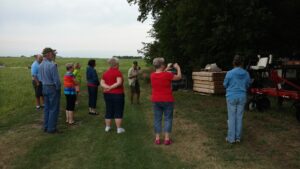
- During the growing season, local Natural Resources Conservation Service (NRCS) staff have been kept up-to-date with progress and visited the farms on several occasions.
- There are tentative plans to present at the local Paton-Churdan School Science Fair next year.
- The Non-GMO Report plans to publish an article highlighting the project in late Spring, 2018.
- Many local farmers visited the farms to take a look for themselves and six Iowa farmers, most of whom are PFI members, have adopted the process and purchased roller-crimpers.
- Many presentations have occurred at local, regional and national conferences by other adopters of the practice and articles, along with newsletter stories, have appeared on several occasions in print and online media of primary farming-related organizations.
Educational & Outreach Activities
Participation Summary:
Many different methods were employed, e.g., field day, presentations, face-to-face and phone consultations, hand outs, etc.
Learning Outcomes
What did you and/or others learn from this grant?
Cover crops are an effective way to promote weed suppression, facilitate nutrient cycling, prevent erosion, retain moisture and increase organic matter. Cereal rye acts as a super cover crop for these purposes and is rather easily roller crimped in the spring. We want to extend these findings to determine if there are ideal planting and roller crimping dates using an earlier maturing cultivar of rye.
As for Hairy Vetch, we need to experiment using a tactic learned from Jeff Moyer of the Rodale Institute. The strategy involves mowing the vetch early in the spring growing season which acts to "trick" the vetch into accelerating its growth toward the reproduction stage. If this works, then we could roller crimp the vetch earlier to allow for planting the corn earlier and utilizing the N from the decomposition of the vetch earlier in the growing cycle.
How has this affected your farm or ranch operation?
The results have encouraged us to continue using cover crops and adjust our maintenance strategies to better accommodate the potential benefits. In particular, we need to make sure we have the equipment necessary ready for action to overcome challenges so we can meet the relatively short window of opportunity for planting and termination of the cover crops. In an organic operation, organic matter increases are central to building soil health and cycling nutrients. In this regard, cover crops significantly contribute to increases in organic matter, disturbances in weed seed bank deposits, retention of moisture and the overall aggregate structure of the soil.
Did you overcome your identified barrier, and if so, how?
The only barrier in this project was the unknown factors of how well the rye would act to suppress weeds and if the hairy vetch would overwinter. We did have encouraging data from past research in Wisconsin and Minnesota, but our intentions on such a larger scale than plot trials was a bit harrowing. The first year results were promising and we learned that we can better prepare for potential obstacles by choosing the most appropriate earlier maturing cultivars of cover crops for our area.
What are the advantages and disadvantages of implementing a project such as yours?
The risk involved is substantial because so much depends upon the weather. For example, if one cannot get the cover crop planted at the ideal time (mid-September) there is the possibility of stymieing spring growth which could affect spring planting and cover crop termination timelines. Then again, if the weather cooperates the advantages are myriad in terms of facilitating increased soil health, weed suppression, nutrient cycling, water infiltration, erosion control, organic matter and N availability.
There is a middle-ground though, since a farmer with access to a high residue cultivator could mitigate any excessive weed pressure in case the rye cover was thin and/or had to be terminated earlier than ideal and thus only provide minimal weed suppression. Row spacing could be an issue in this regard, so 30" spacing might be best, in particular for the no-till operation, to allow for cultivation if necessary.
If asked for more information or a recommendation concerning what you examined in this project, what would you tell other farmers or ranchers?
Cover crops are a good thing whether one is a conventional, transitioning and/or an organic farmer. Independent of farming style, nitrate leaching and erosion are challenging issues that cover crops help to mitigate. For the organic farmer, cover crops are imperative because so much depends upon microbial activity and ultimately, soil health. In addition, for the organic farmer, a roller crimper can help to reduce forms of secondary tillage and this helps to keep carbon reserves in check. For the conventional farmer, cover crops can help stabilize soil movement and erosion and provide some organic matter. Since it is more common to chemically terminate the cover crop early in the spring, the other benefits mentioned are minimized since biomass is significantly reduced.
Project Outcomes
The most common concern among organic farmers who attended our field day was weed suppression potential. One farmer in Northeast Iowa stated "I have to find a way to control annual weeds on some of my slopes and if this strategy could work, I am ready to buy a roller-crimper." Another farmer in Southwest Iowa, who also ended up purchasing a roller-crimper, said: "this seems like a reasonable investment given the importance of controlling weeds in an organic operation."
There were many anecdotal comments like these over the last couple of years...at presentations, through phone consultations and in more casual settings. Essentially, weed suppression was the central concern since out-of-control fields have such a negative influence on yields and successive weed seed banks because there are very few mechanical operations available once the cash crop has passed the early growing stages.
Through personal correspondence with all of the farmers that actually bought roller-crimpers over the last year and one-half, the general consensus was that the investment was worth it
It is important to expand these findings to determine if cover crop planting and termination dates can enhance the potential of positive effects. One way to explore this possibility is to experiment with varying dates of termination. In other words, if soybeans could be planted more in line with a normal planting window and terminated well after emergence without injuring the newly emerged plants, then the soybeans could benefit because this action would extend weed suppression and let canopy closure take over after the rye lessens its weed suppression effects.
In addition, since we have learned that the allelopathic effect of the rye does have a detrimental effect on soybean growth during the earlier stages, perhaps this detriment would be reduced since the rye was terminated after the soybeans had a chance to accelerate its growth past the V1 and V2 stages. If that was the case, then the soybeans could perhaps reach the pod set stage earlier and thus be more productive. As a result, this could facilitate the likelihood of increased yields. Currently, there are several farmers willing to test this possibility.
Similarly, hairy vetch as a cover crop offers the opportunity to provide substantial amounts of N availability for corn production, which could lessen the need for alternative sources and thereby reduce the potential of nitrate leaching. It could be possible, based on results from trials at the Rodale Institute, to better manage the accelerated spring growth of the vetch by mowing it once or twice early in the spring season. If this action was successful, then the vetch would flower earlier and could be roller crimped sooner allowing for corn planting more in line with the normal planting window. This practice, in turn, would accelerate the decomposition of the vetch so N availability would occur earlier allowing for uptake by the corn at an optimal stage.
